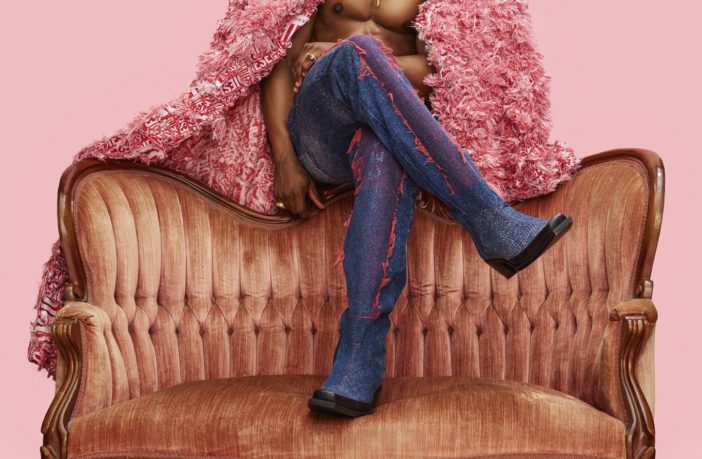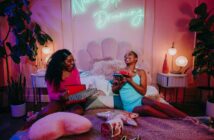The recent hot, steamy goodness that is Jonathan Majors gracing EBONY’s digital February 2023 cover has completely obliterated these social media streets. In the third iteration of the EBONY cover from this month’s roll-out, Marvel’s Ant-Man and the Wasp: Quantumania star is seen sitting atop a fancy rose-colored velvet divan, donning a shaggy petal-pink jacket over his ripped biceps and pecs, printed-denim jeans and heeled cowboy boots.
Stylist Alexander Julian drew inspiration for this look from the anime character Donquixote Doflamingo from the show One Piece. “I believe you can be inspired by anything—your surroundings, the people you are with, what you see, color and more. I love anime, I’ve watched it for years. I draw a lot of style inspiration from anime, and One Piece is particularly stylish. I like the show not just because it is anime but because it talks about real-world issues like slavery, government corruption and other mature themes,” says EBONY’s February cover shoot stylist.
There is no agenda out there to emasculate Black men. If anything, there is a mission to allow them to feel liberated enough from the shackles of hegemonic masculinity—the dictation that governs how a man should act in society based on outdated rules—to embrace whatever self-expression feels best for them.
“Cosplay wasn’t the shoot’s theme but my personal beliefs about styling led me to find an innate inspiration from Doflamingo which is funny because he is extremely masculine in the show,” continues Julian. “Black comic book fans would likely resonate with this because there is a lot of crossover between comic book/Marvel fans and anime fans. That was one of the reasons I chose to call this out in his look because it would resonate with a specific group of people who have poured themselves into these mediums that have not always been socially accepted. These genres have millions of Black fans, who are not always represented in the fandom.”
While a great deal of you shared a very positive response to the cover (we thank you, of course), some of the opinionated remarks took a more negative stance. One now-deleted tweet, in particular, spoke about Majors’ so-called emasculation, prompting a flurry of related backlash about what a Black man should ultimately look like. Furthermore, the discourse brought to life the antiquated views about how the way in which a Black male presents himself inherently speaks to his strength and capabilities as a man. Even more gross was the anti-Black rhetoric used to critique his appearance coming directly from other Black men and women.
As the kids say today—BFFR (Be Freaking For Real). Are you not embarrassed to have your true colors pop out this way? As we continue to fight for a more equitable world that sees Black people in their fullness, we should not pick and choose when to be open-minded. The influx of negativity regarding Majors’ blush-colored coat cover is reflective of so many things still plaguing our community: the chokehold that hyper-masculinity has on a large chunk of us; the failure to imagine Black manhood as something more than physical stereotypes; and the ways in which internalized homophobia dictates folks’ daily movements.
To be honest, the clear discomfort shown toward Majors’ brings to light character flaws that these individuals share rather than it being an attack on his manhood. There is no agenda out there to emasculate Black men. If anything, there is a mission to allow them to feel liberated enough from the shackles of hegemonic masculinity—the dictation that governs how a man should act in society based on outdated rules—to embrace whatever self-expression feels best for them. Another angle of this conversation deals with how a man must be able to fight well and “shoot sh*t up” if he is going to wear pieces like that to be still considered a “manly” man. But we must realize, the more we force Black men to subscribe to “thug-ish” stereotypes, the further away we are drifting from true freedom.
Plus, really, if we are talking about Black fashion, Black men have been rocking the hell out of pieces deemed “effeminate” for decades. Think Prince, the Isley Brothers and the Gap Band in their early years or Kid Cudi and Andre 3000 today. But why does how one man chooses to dress have to be coupled with his ability to show strength. This is not what we should be equating Black manhood to.
Regardless of what you think of Majors, he does not deserve the disrespect. If in 2023, we’re still debating what colors a man should wear in order to be a true man instead of judging him by the content of his character and the validity of his actions that contribute to society, then we have a much greater problem to solve.



